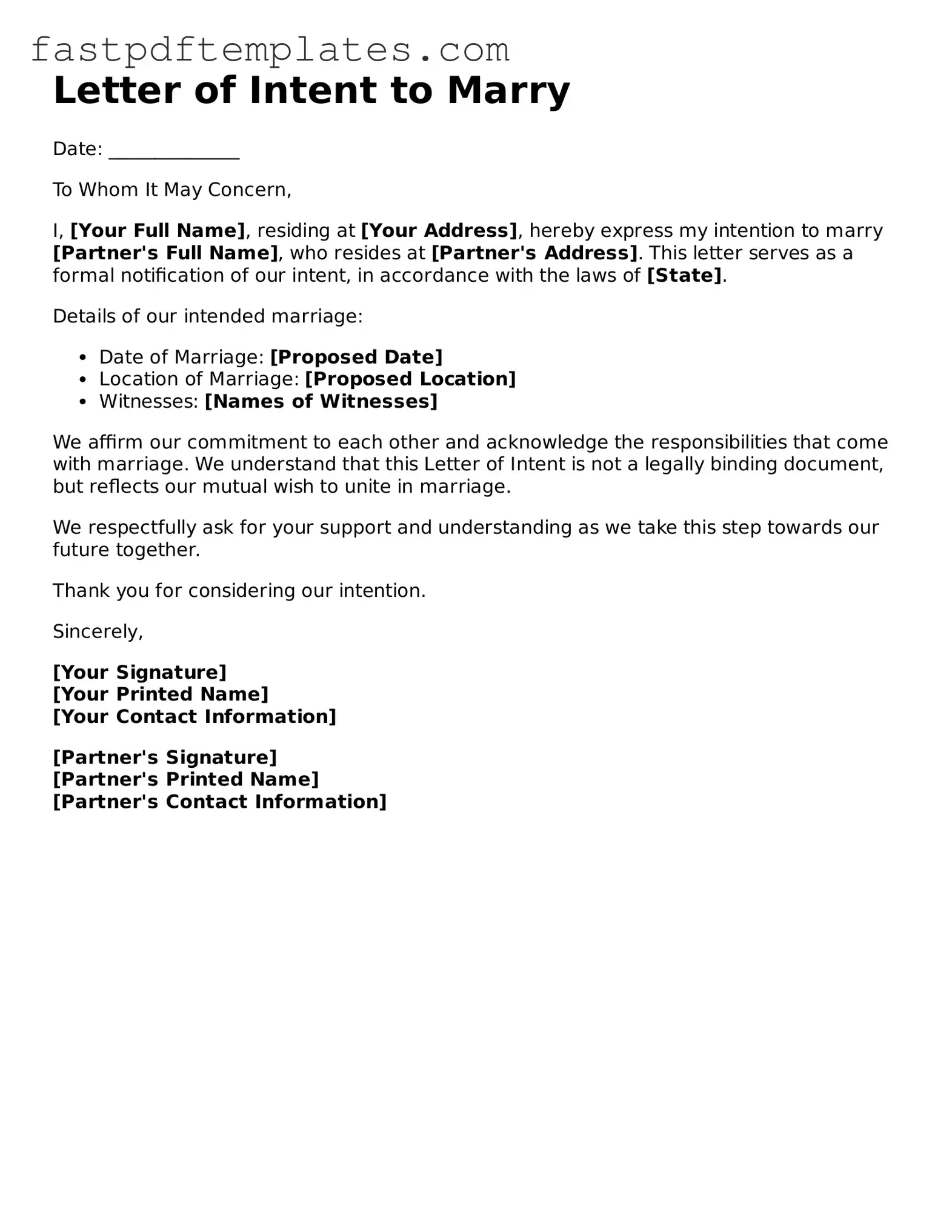The Letter of Intent to Marry form shares similarities with a Prenuptial Agreement. Both documents serve as a precursor to marriage, outlining the intentions and expectations of the parties involved. A Prenuptial Agreement typically details how assets will be divided in the event of a divorce, while a Letter of Intent to Marry expresses a mutual desire to enter into a marital relationship. This mutual understanding can help set the tone for the partnership, much like a prenup aims to clarify financial matters before they arise.
Another document akin to the Letter of Intent to Marry is the Cohabitation Agreement. While a Letter of Intent signals an upcoming marriage, a Cohabitation Agreement is often used by couples who choose to live together without formalizing their relationship through marriage. Both documents outline the rights and responsibilities of each partner, helping to prevent misunderstandings. They can establish expectations regarding finances, property, and even household duties, creating a framework for a harmonious living arrangement.
The Affidavit of Support is also somewhat comparable to the Letter of Intent to Marry. This document is often used in immigration cases, where one partner agrees to financially support the other during their stay in the United States. While the Letter of Intent expresses a commitment to marry, the Affidavit of Support represents a commitment to provide for a partner's well-being. Both documents reflect a promise to support one another, whether emotionally or financially.
Similar to the Letter of Intent to Marry is the Declaration of Domestic Partnership. This document is used by couples who wish to formalize their relationship without entering into marriage. Both the Declaration and the Letter of Intent signify a commitment to one another, establishing rights and responsibilities within the relationship. They can serve as official recognition of the couple's partnership, even if they do not choose to marry immediately.
The Marriage License Application is another document that relates closely to the Letter of Intent to Marry. Both are essential steps in the journey toward marriage. The Letter of Intent outlines the couple's intention to marry, while the Marriage License Application is a legal requirement that allows them to obtain the necessary permission to wed. Each document plays a crucial role in the process of formalizing a romantic relationship.
A Commitment Ceremony Agreement also shares similarities with the Letter of Intent to Marry. While a Letter of Intent indicates a desire to marry, a Commitment Ceremony Agreement can be used by couples who want to celebrate their relationship without legal marriage. Both documents express a deep commitment to one another, often accompanied by a public declaration of love and partnership. They serve to solidify the bond between partners, regardless of their marital status.
The Separation Agreement can be seen as a counterpart to the Letter of Intent to Marry, albeit from a different perspective. While the Letter of Intent expresses a desire to unite, a Separation Agreement outlines the terms under which a couple will live apart. Both documents address the dynamics of a relationship, whether it is one of unity or separation. They help clarify expectations and responsibilities, ensuring that both parties understand their roles moving forward.
The Affidavit of Marriage is another document that parallels the Letter of Intent to Marry. This affidavit is often required as proof of marriage for various legal purposes. While the Letter of Intent indicates a future commitment, the Affidavit of Marriage serves as confirmation of that commitment once the marriage has taken place. Both documents highlight the significance of the marital bond, though they exist at different stages of the relationship.
The Postnuptial Agreement can also be likened to the Letter of Intent to Marry. Although a Postnuptial Agreement is created after marriage, it serves a similar purpose in clarifying expectations and responsibilities between partners. Both documents aim to foster open communication about important issues, whether they pertain to finances or other aspects of the relationship. They provide a framework for couples to navigate their partnership more effectively.
Finally, the Intent to Adopt form bears resemblance to the Letter of Intent to Marry. Both documents express a commitment to a significant relationship—one to marriage and the other to parenthood. The Intent to Adopt outlines the prospective parents' desire to welcome a child into their family, while the Letter of Intent details a couple's wish to unite in marriage. Each document represents a pivotal moment in a couple's journey, highlighting their dedication to building a life together.
